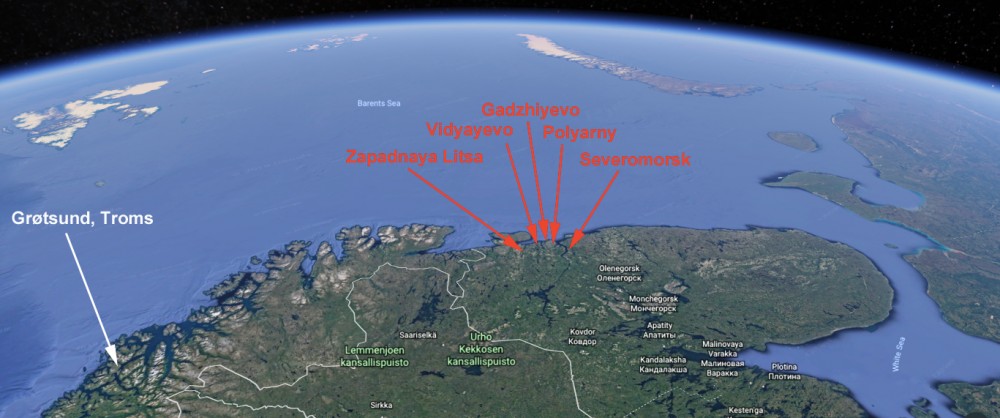
Above, Russian naval bases and facilities on the Barents Sea.
Reader input: a dedicated reader sent me the following video:
https://www.youtube.com/watch?v=3hTjnoctYb8&feature=youtu.be
Reader comment: Unfortunately, we are in a new "cold war" Most of Ronaldus Magnus' great work has been ruined by the neocons and zicons........anonymous
Reader input: a dedicated reader sent me the following video:
https://www.youtube.com/watch?v=3hTjnoctYb8&feature=youtu.be
Reader comment: Unfortunately, we are in a new "cold war" Most of Ronaldus Magnus' great work has been ruined by the neocons and zicons........anonymous
I want to give a special thank you to Al, Dave and Jeanette who sent me valuable information about this incident. This blog is not possible without help of contributors like them.
An incident on July 1 or 2, 2019 killed 14 Russian Navy
sailors and injured more, with reports suggesting that the sailors sacrificed
themselves to put the fire out. On Russian television, President Vladimir Putin revealed that seven of the deceased were captains first rank,
and two were awarded the distinction “Heroes of Russia” in the past. That’s an
unusually high concentration of decorated officers.
A conflicting report on Twitter claims that the fire took place not on Losharik itself but the mother sub that carried it, Podmoskovye.
Podmoskovye is a modified ballistic missile submarine designed to carry smaller special mission-engineering (read: spy submarines) like Losharik to operational areas.
The Losharik (AS-12) is a deep diving special mission/engineering submarine (aka a spy submarine). According to submarine authority H.I. Sutton, Losharik entered service in 1997, displaces less than 1,000 tons (the U.S. Navy’s newest Virginia-class attack submarines 7,800 tons), and is about 230 feet long, 23 feet wide, and typically has a crew of 25. She is powered by a single 5-megawatt nuclear reactor.
The sub is named after a Russian cartoon horse made up of
juggling balls, and the name is a play on the fact that the submarine is
internally made up of up to seven interlinked high pressure orbs. Each orb is
designed to provide protection from the extreme pressures of deep sea diving.
Sutton believes this gives Losharik the
ability to dive to depths up to 1,000 meters (3,280 feet).
Losharik is designed to operate on the
ocean floor, front-mounted flood lights, remotely operated arms for manipulated
equipment, and retractable ski feet for sitting on the seabed. Although
described as a scientific research submarine, she is assigned to the Main Directorate
for Deep Sea Research, known by its Russian acronym GUGI. The submarine is
considered highly classified and the only known photo appeared in the Russian
magazine version of Top Gear, when it accidentally sailed into a camera shot.
GUGI reports directly to the General Staff
of the Armed Forces and GUGI’s fleet of nine submarines frequently depart on
“special missions”. “Little is known about the nature of those voyages,” The
Barents Observer writes, “except reports of significantly increased
activity along sub sea cables which carry global electronic communication.”
In addition to eavesdropping, submarines like Losharik
can “bring, or remove, other small installations
and devices for military purposes to be placed on the sea floor. In the Arctic,
or at other locations important for the Russian navy. Such devices can be
noise-makers to distract foreign submarines when Russian submarines sail out
from the Kola Peninsula to the North Atlantic. Other listening devices can
detect sounds made by the propellers of enemy ships. The submarine can launch
and recover unmanned sub sea vehicles.” Losharik is allegedly now in Severommorsk, the headquarters of the Russian fleet. Unofficially the sub is reported to be at Gadzhiyevo.
Russian Service (RS) spoke with Dmitry Gorenburg, an associate with the Davis Center for Russian and Eurasian Studies at Harvard University and a researcher with the U.S.-based Center for Naval Analyses, and asked him about the Losharik incident and the state of Russia's nuclear submarine fleet.
RS: What can
you tell us about the Losharik submarine and its function?
Dmitry Gorenburg: This submarine has an unusual
construction with a double hull. The exterior is made of titanium, while the
internal hull comprises several isolated spheres. It is not, strictly speaking,
a "real" submarine because it is transported using large atomic
submarines, usually the Orenburg, although the Belgorod can also serve. Because
of its internal nuclear reactor, it can remain submersed for extended periods
and can operate almost noiselessly. According to some sources, it is the
quietest submarine in the Russian arsenal.
It
is not completely clear what its uses are. Officially, they don't say that it
is used for deep-sea research. U.S. military experts believe that it is designed
to attach itself to undersea cables to eavesdrop on communications or to
destroy them in the event of a conflict. It is apparently able to disrupt the
normal functioning of the SOSUS [sound surveillance system], which is a network
of hydro acoustic sensors placed in the North Atlantic between Greenland and
Britain to track the movements of Russian submarines from the Norwegian and
North seas into the Atlantic Ocean.
In
the present case, according to Russian sources, this submarine was located in
Russian territorial waters not far from Murmansk and, most likely, was engaged
in studying the seafloor in order to improve the navigation practises of
Russian submarines (Your Watchman, yea, sure, if you believe that I have a bridge to Hawaii I will sell you).
RS: Can you tell us anything about the incident that
killed the 14 sailors?
Gorenburg: It is difficult to say anything
definite. It is clear that a fire broke out on board that they managed to put
out, but it was very serious and caused fatalities. We might suppose that the
fire was not discovered quickly and that measures to contain it and prevent
fatalities were not able to be taken. Of course, it could have been much worse
– the loss of the entire crew and the vessel.
In
general, fires aboard submarines are quite rare. In the 1960s, there were two
or three fires aboard U.S. submarines at sea, if I remember correctly. Most
such incidents occur during repair work. This is also true for Russian
submarines. Overall, this is an unusual occurrence.
RS: The Russian statement said the sailors died from
"poisoning by the by-products of a fire." Surely there are systems
for cleaning the air on modern submarines. What do you make of this strange
formulation?
Gorenburg: One problem with submarines is
that they are a very restricted space. All submarines have life-support
systems. There are spaces from which crew members can be evacuated in an
emergency. Without knowing more about the construction of this vessel or what
actually happened, it is impossible to say why people were not able to escape
the fire.
RS: Does this incident tell us anything about the
reliability of Russian submarines?
Gorenburg: You can't draw conclusions based
on one incident, but if we look at long-term tendencies, we can see some
unusual things.
For
instance, over the last 20 years, there have been several incidents in the U.S.
Navy involving ship collisions, both submarines and surface ships. In part,
this can be explained by the scale of U.S. naval operations. But there have
been almost no problems caused by the technical condition of the vessels or the
breakdown of crucial systems or unreliable technology.
The
Russian fleet has considerably more incidents. It isn't clear if this is
because of the failure of crews to follow established procedures and
instructions or because of the physical condition of the ships or defects in their
construction. However, if we look at the statistics, every five or six years
there is an incident involving a Russian submarine -- a fire or a breakdown
requiring serious repairs. For U.S. submarines -- not counting problems caused
by navigation faults -- such incidents happen once in 15 or 20 years.
RS: This submarine has a nuclear reactor on board.
Is that a cause for concern?
Gorenburg: If they brought the vessel back
to the base at Severomorsk and moored it there, then I'd assume that means
there is no danger of radiation leaks. In general, modern nuclear reactors are
designed with built-in fail-safes and they are rather reliable and capable of
withstanding a very serious fire. It might have been that the fire did not
start in the reactor section and that the crew was able to prevent its spread
to the reactor.
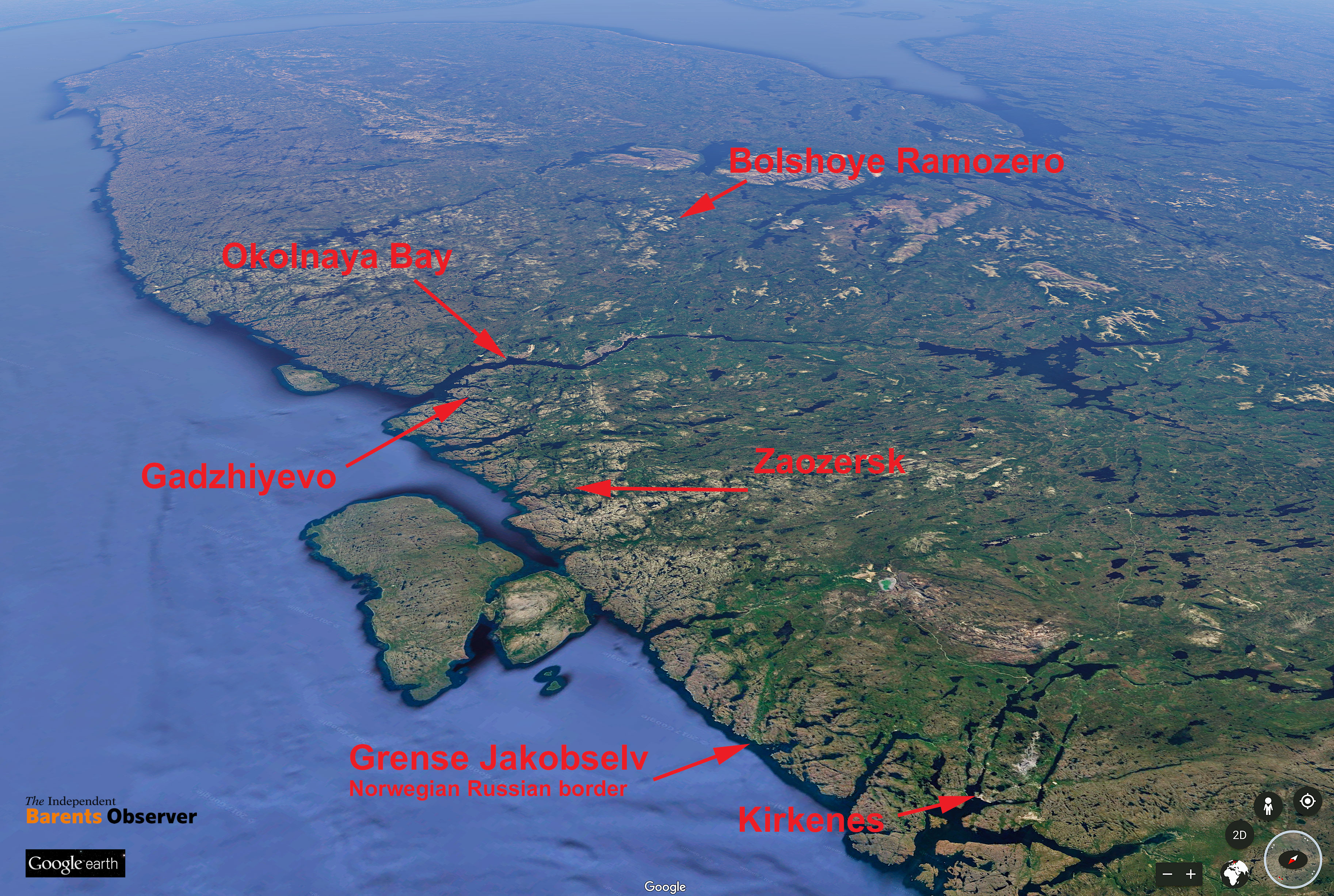
Above is a photo of the Podmoskovye submarine.
New article starts below.
New article starts below.
Reports reaching DEBKAfile’s (DF) military sources on Tuesday July 2, 2019 say that a US submarine intercepted
a Russian nuclear sub in American waters opposite Alaska, now thought to be in the Atlantic Barents Sea. The Russian sub
escorting the nuclear submarine responded with a Balkan 2000 torpedo and
scuttled the US vessel. Urgent consultations in both the White House and the
Kremlin were taking place on Tuesday night. US Vice President Mike Pence called
off an appearance in New Hampshire and remained in Washington for a
conference called by President Donald Trump without explanation.
Russian President
Vladimir Putin cancelled an engagement and headed for the Kremlin to confer
with Defense Minister Sergei Shoigu and military chiefs, after learning that 14
submariners died in a fire that broke out on a nuclear-powered “experimental
submarine in Russian waters.” This account carried in Russian media varies in
most respects from the DF reports and may refer to a separate incident. They
report between 14 and 17 members of an AS-12 Losharik nuclear powered submarine died of
poisonous fumes caused by a fire aboard the vessel. The submarine was described
as experimental and unarmed but often used in spy missions. It is unclear how
many of the 25 crew survived. Local media suggest four or five are receiving
treatment in Severomorsk’s military hospital for poisoning and concussion
injuries. Another news account said the majority of the officers died in or on
their way to hospital. These reports do not cite the cause of the fire.
DF
is an Israeli intelligence reporting service and can be found online.
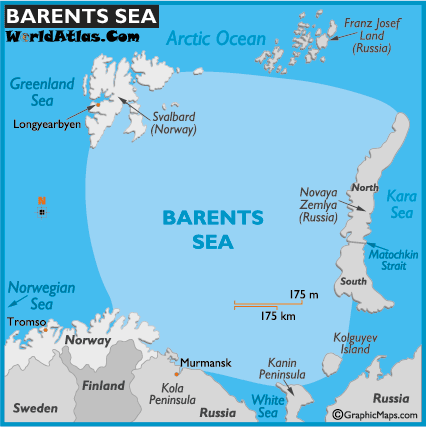
Russian Defence Minister Sergei
Shoigu said the fire broke out on the AS-12 Losharik while the vessel was
measuring sea depths in Russia's territorial waters, and the AS-12 Losharik had
since arrived at the Arctic port of Severomorsk, the main base of Russia's
Northern Fleet.
14 sailors died from being poisoned
by combustion products," he said.
In a televised meeting with his
Defence Minister, President Vladimir Putin said two "Heroes of
Russia" were among the dead, referring to the highest military award
issued in the post-World War II period.
"This is not a regular vessel
... it's a scientific research vessel. It's a highly professional crew,"
he said.
"It is a big loss for the fleet
and for [the] navy in general."
The Ministry said the fire was put
out thanks to the "self-sacrifice of crew members" but did not say
how many people were on board.
The blaze marks the most serious
Russian naval incident since 2008, when 20 people died after a firefighting
system was accidentally triggered while the Nerpa nuclear-powered submarine of
Russia's Pacific Fleet was undergoing trials.
In the deadliest naval incident in
post-Soviet era, the Kursk nuclear submarine exploded and sank on August 12,
2000, during naval maneuvers in the Barents Sea, killing all 118 crew members.
The latest incident also took place
in the vicinity of the Barents Sea, but authorities in nearby Norway said they
were monitoring, but had not detected, abnormally high levels of radiation.
Per Strand, a director at the
Norwegian Radiation and Nuclear Safety Authority, said Russian officials had
told his agency that a gas explosion took place on board the submarine, though
Russia denied this.

The
AS-12 Losharik was constructed and launched under a veil of secrecy, but some details of
the project have been reported by Russian media.
According
to an archived report in Russian newspaper Izvestia, the Losharik was launched in
2003.
It
is described as the most advanced and most obscure Russian submarine and is
reportedly named after a Soviet-era cartoon character — a toy horse made of
small spheres.
The
name is apparently explained by the unique design of its internal hull, which
is made of several titanium spheres capable of withstanding high pressure at
great depths.
It
is reportedly powered by a nuclear reactor and was built over a 15-year period
under a veil of secrecy.
None
of the claims have been independently confirmed.
In 2012, the vessel was involved in
research intended to prove Russia's claim on the vast Arctic seabed.
It
collected samples from the depth of 2,500 meters, according to official
statements at the time. Regular submarines can typically dive to depths of up
to 600 meters.
Some
observers have speculated that the vessel could be capable of going as deep as
6,000 meters.
Analysts
have suggested one of its missions could be disrupting communication cables on
the ocean bed.
The
Losharik is carried under the hull of a mother submarine, the nuclear-powered Podmoskovye or BS-136 Orenburg.
Below is a photo of special purpose submarine BS-64, project 09787 Podmoskovye.
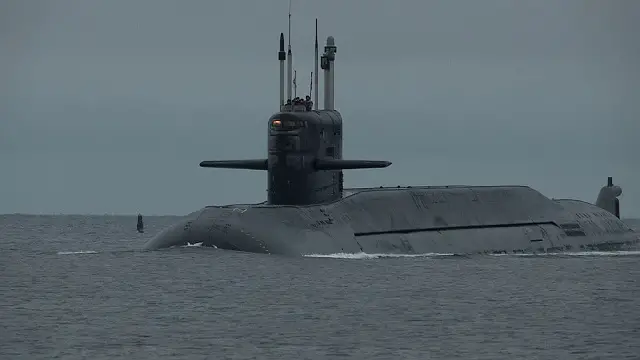
Below is a photo of the BS-136 Orenburg

Although
details remain sketchy, the 510 foot long Orenburg may have been adapted to multiple mother ship
projects, with the Project 10831 Losharik being
the largest rumored to be carried. Other smaller, but still highly capable
submersibles were also said to have been used with the design. One of these is
said to have been called 'White
Salmon' with a dive depth of 1km, while Losharik is
said to have a dive depth of a whopping 6km.
Although
the Orenburg's missile compartment and
ventral section was cutout to make room for stowing fairly
large submarines, the Losharik,
at least the submarine pictured in the Top
Gear Magazine and other shots seen in this post is said to be
around 250 feet long, making it far larger than what we would traditionally
call a 'midget submarine.' Its reactor is said to provide around 10,000shp
making the boat rivaling fast attack nuclear submarines in speed, but its job
is clearly one of espionage and surveillance due to its deep diving abilities,
where it can plant listening devices, manipulate those of the enemies, tap into
fiber optic cables or sit for long periods of time surveying its dark domain.
This job is similarly performed for the U.S. by the USS
Jimmy Carter, a highly modified variation of the deep-diving Seawolf
Class design, along with smaller, remote controlled
submersibles.
An alleged photo of the Lorsharik are below.

Russian
news reports said that while the Losharik officially belonged to the Northern
Fleet, it answered directly to the Defence Ministry's Department for Deep-Sea Research,
reflecting the high sensitivity of its missions.
The Russian navy also uses Priz-class
and Bester-class deep water vehicles, which have a hulls built of titanium and
are capable of operating at a depth of 1,000 metres.
The small vehicles have a crew of two
and are primarily intended for rescuing submariners in case of incidents.
Such vessels are transported to the
area of operation by a carrier vessel and can operate autonomously for up to
120 hours.


Above, graphics of the Losharik.
Hal
Turner reported the following on Tuesday on his radio show: An American submarine operating off the coast of
Alaska was REPORTEDLY torpedoed and SUNK during a firefight with a Russian
submarine, after the American sub allegedly intercepted the Russian sub in
American waters.
The Russian submarine allegedly sustained heavy damage in the fight,
with upwards of 14 crew killed, but it made it back to its base in Russia.
I have calls into the Pentagon and to my Intel Sources seeking to
confirm (or deny) this information.
No word on US casualties.
Emergency meetings have been taking place at the White House this
afternoon, (Tuesday July 2, 2019) with Vice President Pence being called back
to the White House and having to cancel his scheduled trip to New Hampshire.
As Pence was being called back, word broke in Russian media that Russian
President Vladimir Putin cancelled a public event he had long scheduled, and
diverted immediately for a meeting with his Defense Minister.
At that meeting, both Putin and the Defense Minister SUMMONED the
General Secretary of the Russian Armed Forces to the meeting.
While that was taking place, the European Union headquarters in Brussels
Belgium called an Emergency meeting of the EU National Security Council and,
separately, the British Government called a COBRA meeting for its government.
This is a developing story. Check back for updates.
UPDATE 5:45 PM EDT --
Russian President Vladimir Putin has ordered the country’s defense chief
to travel to a northern naval base to conduct a probe after a
fire on a deep-sea research submersible killed 14 crew members.
(Hal Turner Remark: A
fire huh? Hmmmmm. Caused by what? A firefight with a US
Submarine, perhaps?)
Putin on July 2 called the incident a “terrific loss” and told Defense Minister Sergei Shoigu to “personally hear reports” and direct the Investigative Committee to “definitely establish the causes behind this tragedy."
Putin on July 2 called the incident a “terrific loss” and told Defense Minister Sergei Shoigu to “personally hear reports” and direct the Investigative Committee to “definitely establish the causes behind this tragedy."
Putin’s meeting with Shoigu came after the Defense Ministry said earlier
in the day that 14 sailors were killed when a fire broke out on July 1 aboard a
submersible carrying out research work in Russian territorial waters.
(Hal Turner Remark: "In
Russian territorial waters???" Why the need to say THAT?
Something's fishy already with the public statements from Russia. And US/EU/UK
governments do not have "emergency meetings" over a "fire"
inside a Russian submarine. Nope. I don't buy this one
bit. This sounds like a cover story to me. Still digging via my
intel contacts.)


Above, a Russian poster depicting the Losharik. Below are more details about BS-64 Podmoskovye
BS-64_Podmoskovye
BS-64 Podmoskovye - New Russian Special Mission spy-sub
 BS-64 Подмосковье (Podmoskovye = ‘Moscow Oblast’) is a Project 09787 DELTA-IV STRETCH ballistic missile submarine which has been converted into a host submarine for nuclear powered midget-subs. She was relaunched on October 22nd and is expected to join 29th Separate Brigade of submarines of the Northern Fleet at their secretive base at Olenya Guba (Deer Bay) on the Murmansk Oblast. The 29th Separate Brigade operate a range of Special Mission submarines (read ‘Spy submarines’) for GUGI (Main Directorate Deep Sea Research). Podmoskovye will be used as a Host Submarine (‘mother submarine’) for some of the midget submarines based there, most likely including the elusive Project 10831 LOSHARIK.
BS-64 Подмосковье (Podmoskovye = ‘Moscow Oblast’) is a Project 09787 DELTA-IV STRETCH ballistic missile submarine which has been converted into a host submarine for nuclear powered midget-subs. She was relaunched on October 22nd and is expected to join 29th Separate Brigade of submarines of the Northern Fleet at their secretive base at Olenya Guba (Deer Bay) on the Murmansk Oblast. The 29th Separate Brigade operate a range of Special Mission submarines (read ‘Spy submarines’) for GUGI (Main Directorate Deep Sea Research). Podmoskovye will be used as a Host Submarine (‘mother submarine’) for some of the midget submarines based there, most likely including the elusive Project 10831 LOSHARIK.Source: Zvezdochka-ru.livejournal (in Russian)
Original artwork

Artist's impression showing LOSHARIK midget sub below the hull and a SHELF nuclear reactor pod as payload.
It is likely that Podmoskovye will be involved in the laying of the ‘SHELF’ Russian arctic sensor network. See Russia seeks submarine advantage in Arctic (SHELF system, GUGI special mission subs)
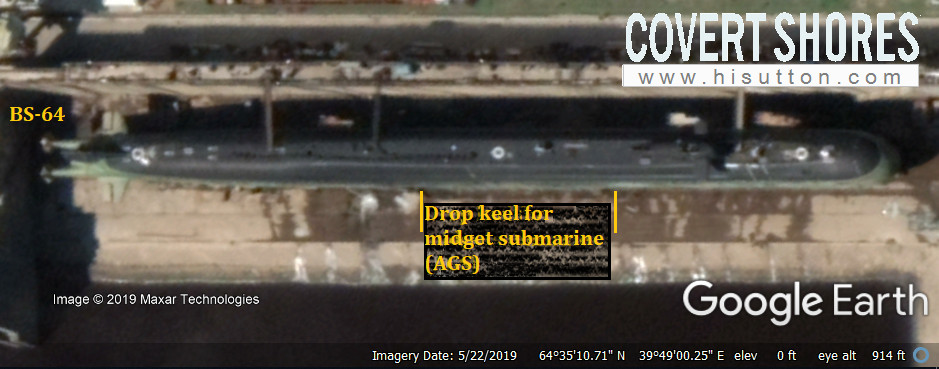
Conversion to Special Mission Host Submarine
Work on BS-64 started at the Star shipyard in Severodvinsk on the White Sea in 1999 although she laid up unfinished for many years until 2012 when work resumed. The missile section, which originally held 16 x R-29RMU Sineva (SS-N-23A SKIFF) liquid-fueled missiles which each carry four independently targetable reentry vehicles (MIRVs) was cut out and replaced by a very long hull insert of similar diameter. The insert is slightly longer, adding about 7m to the overall length (174m vs 167m). Despite the ample space provided by the double-hull configuration a raised deck is still required although the ‘hump back’ of the original missile section is removed.

Example DELTA-IV SSBN before modification. Note the hump-back section for the missiles.
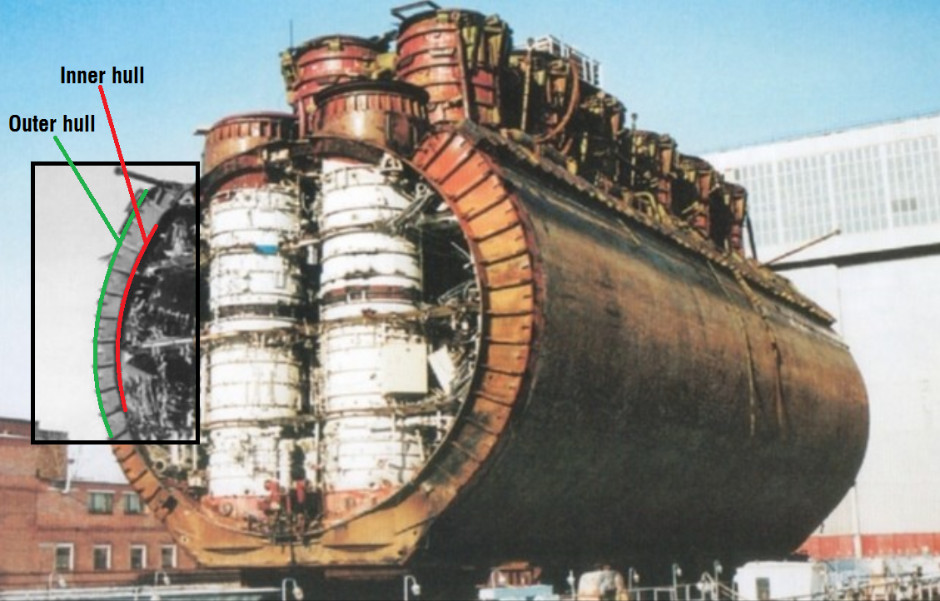
Missile section of a DELTA-III submarine showing the double-hull construction. The section removed from Podmoskovye was similar.
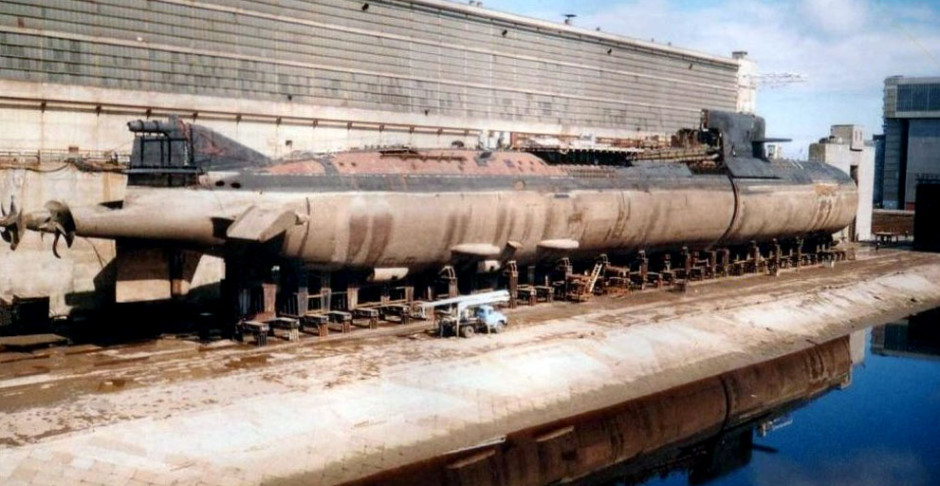
BS-64 during conversion with missile silos already removed, 2005. Source MilitaryRussia.ru
Work on BS-64 started at the Star shipyard in Severodvinsk on the White Sea in 1999 although she laid up unfinished for many years until 2012 when work resumed. The missile section, which originally held 16 x R-29RMU Sineva (SS-N-23A SKIFF) liquid-fueled missiles which each carry four independently targetable reentry vehicles (MIRVs) was cut out and replaced by a very long hull insert of similar diameter. The insert is slightly longer, adding about 7m to the overall length (174m vs 167m). Despite the ample space provided by the double-hull configuration a raised deck is still required although the ‘hump back’ of the original missile section is removed.

Example DELTA-IV SSBN before modification. Note the hump-back section for the missiles.

Missile section of a DELTA-III submarine showing the double-hull construction. The section removed from Podmoskovye was similar.

BS-64 during conversion with missile silos already removed, 2005. Source MilitaryRussia.ru
Related Subs

 Project 09852 Belgorod Special Mission submarine (spy sub)
Project 09852 Belgorod Special Mission submarine (spy sub)

 USS Parche spy sub par-excellence
USS Parche spy sub par-excellence

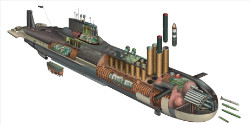 Russian Typhoon Class SSBN
Russian Typhoon Class SSBN




 +
+ 


 Nuclear Missile submarines
Nuclear Missile submarines

 P.09851 KHABAROVSK and KANYON (Status-6)
P.09851 KHABAROVSK and KANYON (Status-6)

 SIERRA Class SSN
SIERRA Class SSN

 Russian Losharik spy sub
Russian Losharik spy sub

 Project 1910 UNIFORM Class deep diving spy sub
Project 1910 UNIFORM Class deep diving spy sub

 USS Halibut
USS Halibut

 USS Seawolf (SSN-575)
USS Seawolf (SSN-575)

 Russian X-RAY Class spy sub
Russian X-RAY Class spy sub

 Russian Sarov experimental sub
Russian Sarov experimental sub

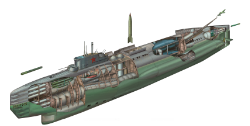 Stalin's Super Sub, Project P-2
Stalin's Super Sub, Project P-2

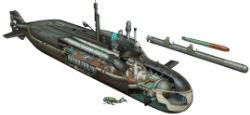 Piranha Class (LOSOS) midget sub
Piranha Class (LOSOS) midget sub

 Yantar spy ship loitering over undersea cables
Yantar spy ship loitering over undersea cables
 Russia seeks submarine advantage in Arctic (SHELF system, GUGI special mission subs)
Russia seeks submarine advantage in Arctic (SHELF system, GUGI special mission subs)

 Poseidon Intercontinental Nuclear-Powered Nuclear-Armed Autonomous Torpedo
Poseidon Intercontinental Nuclear-Powered Nuclear-Armed Autonomous Torpedo

 Nerpa anti-diver UUV
Nerpa anti-diver UUV

 Project 09852 Belgorod Special Mission submarine (spy sub)
Project 09852 Belgorod Special Mission submarine (spy sub)
 USS Parche spy sub par-excellence
USS Parche spy sub par-excellence
 Russian Typhoon Class SSBN
Russian Typhoon Class SSBN



 +
+ 


 Nuclear Missile submarines
Nuclear Missile submarines
 P.09851 KHABAROVSK and KANYON (Status-6)
P.09851 KHABAROVSK and KANYON (Status-6)
 SIERRA Class SSN
SIERRA Class SSN
 Russian Losharik spy sub
Russian Losharik spy sub
 Project 1910 UNIFORM Class deep diving spy sub
Project 1910 UNIFORM Class deep diving spy sub
 USS Halibut
USS Halibut
 USS Seawolf (SSN-575)
USS Seawolf (SSN-575)
 Russian X-RAY Class spy sub
Russian X-RAY Class spy sub
 Russian Sarov experimental sub
Russian Sarov experimental sub
 Stalin's Super Sub, Project P-2
Stalin's Super Sub, Project P-2
 Piranha Class (LOSOS) midget sub
Piranha Class (LOSOS) midget sub
 Yantar spy ship loitering over undersea cables
Yantar spy ship loitering over undersea cables Russia seeks submarine advantage in Arctic (SHELF system, GUGI special mission subs)
Russia seeks submarine advantage in Arctic (SHELF system, GUGI special mission subs)
 Poseidon Intercontinental Nuclear-Powered Nuclear-Armed Autonomous Torpedo
Poseidon Intercontinental Nuclear-Powered Nuclear-Armed Autonomous Torpedo
 Nerpa anti-diver UUV
Nerpa anti-diver UUV It is worth noting that a few U.S. wars have started because of a sunken ship.
1. The sinking of the Battleship Maine in Cuba for the Spanish-American war.
2. Sinking of the Lusitania by a German U-Boat and we go into World War I.
3. The sinking of a whole bunch of ships at a Naval Base named Pearl Harbor and World War II starts.
4. A naval battle in the South China Sea Gulf of Tonkin starts the Viet-Nam war.
5. I guess we could also include the American Revolution due to the Boston Tea Party where Colonial Masons robbed and burned British Ships.
7. I guess the War of 1812 deserves an honorable mention because the Star Spangled Banner was written during a naval bombardment of Fort McHenry.


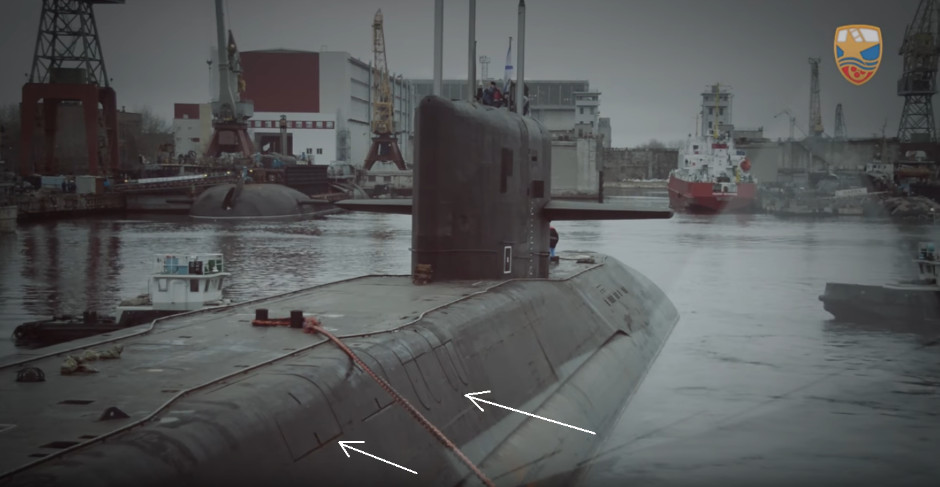
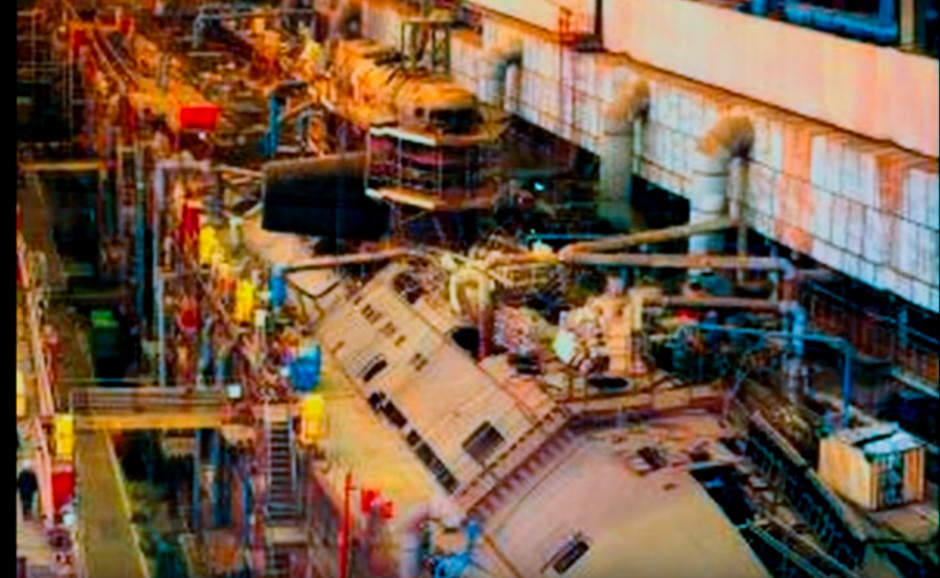

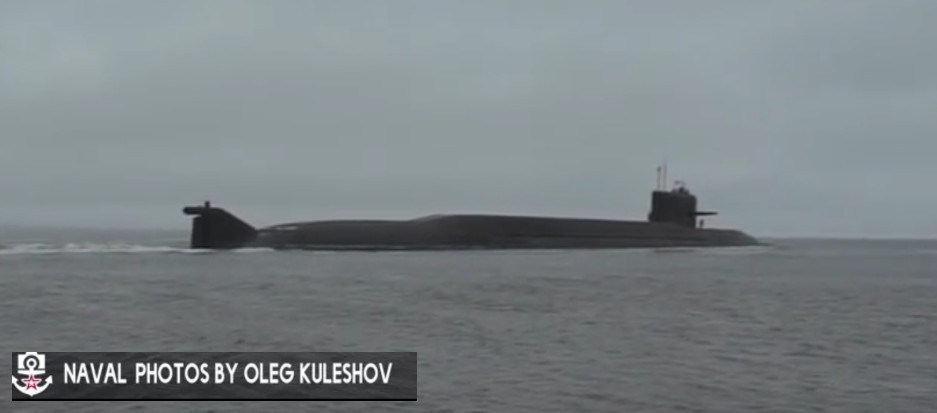
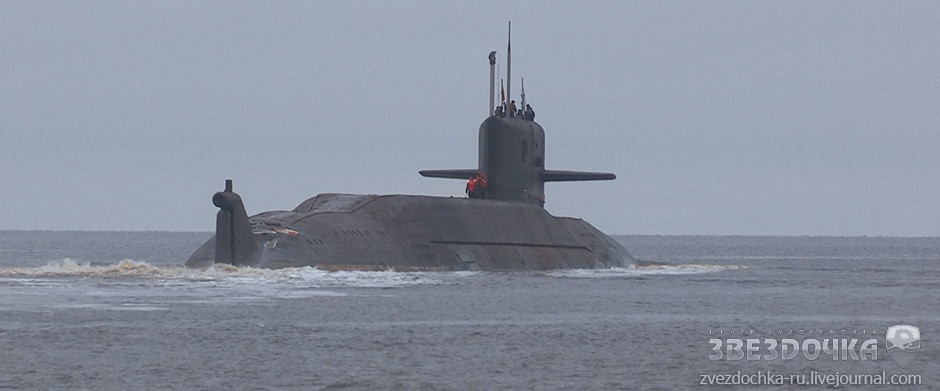
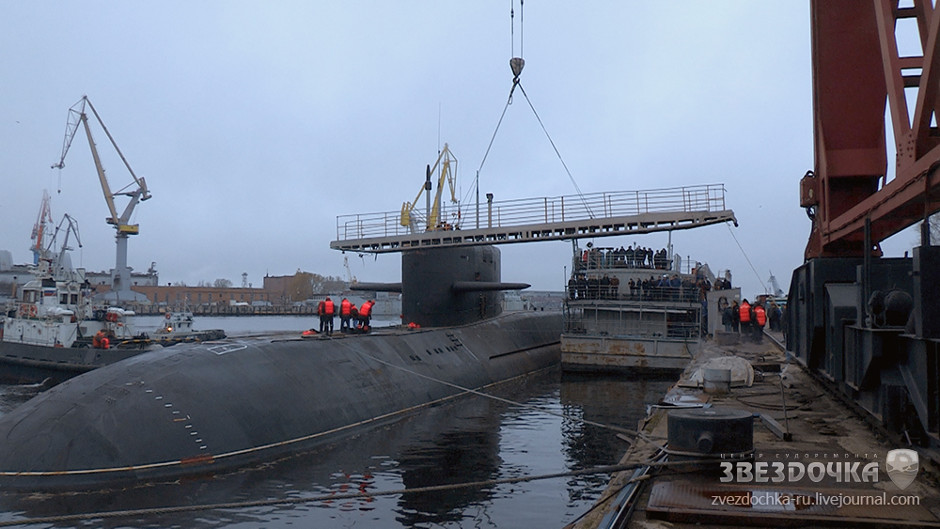
No comments:
Post a Comment